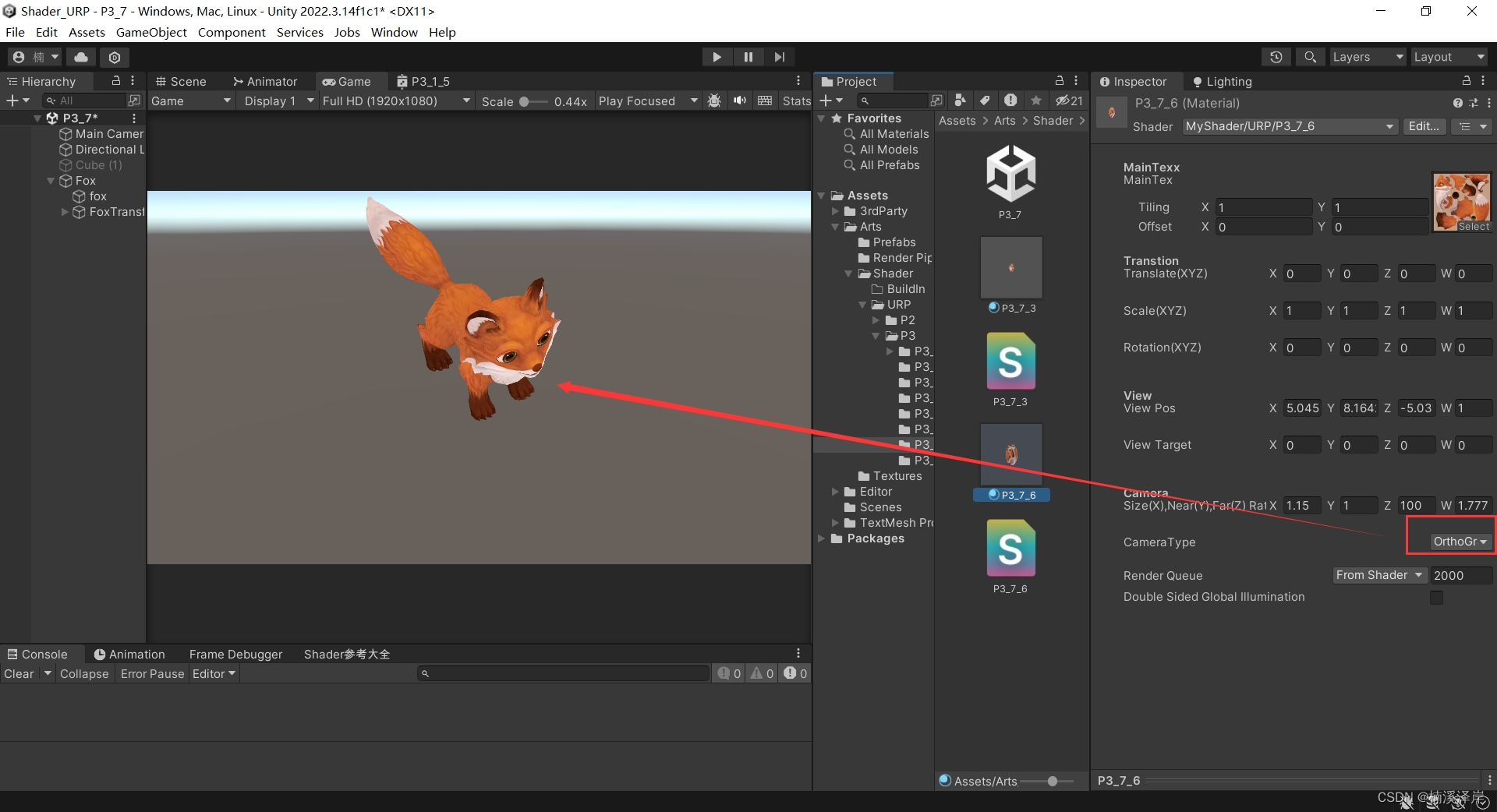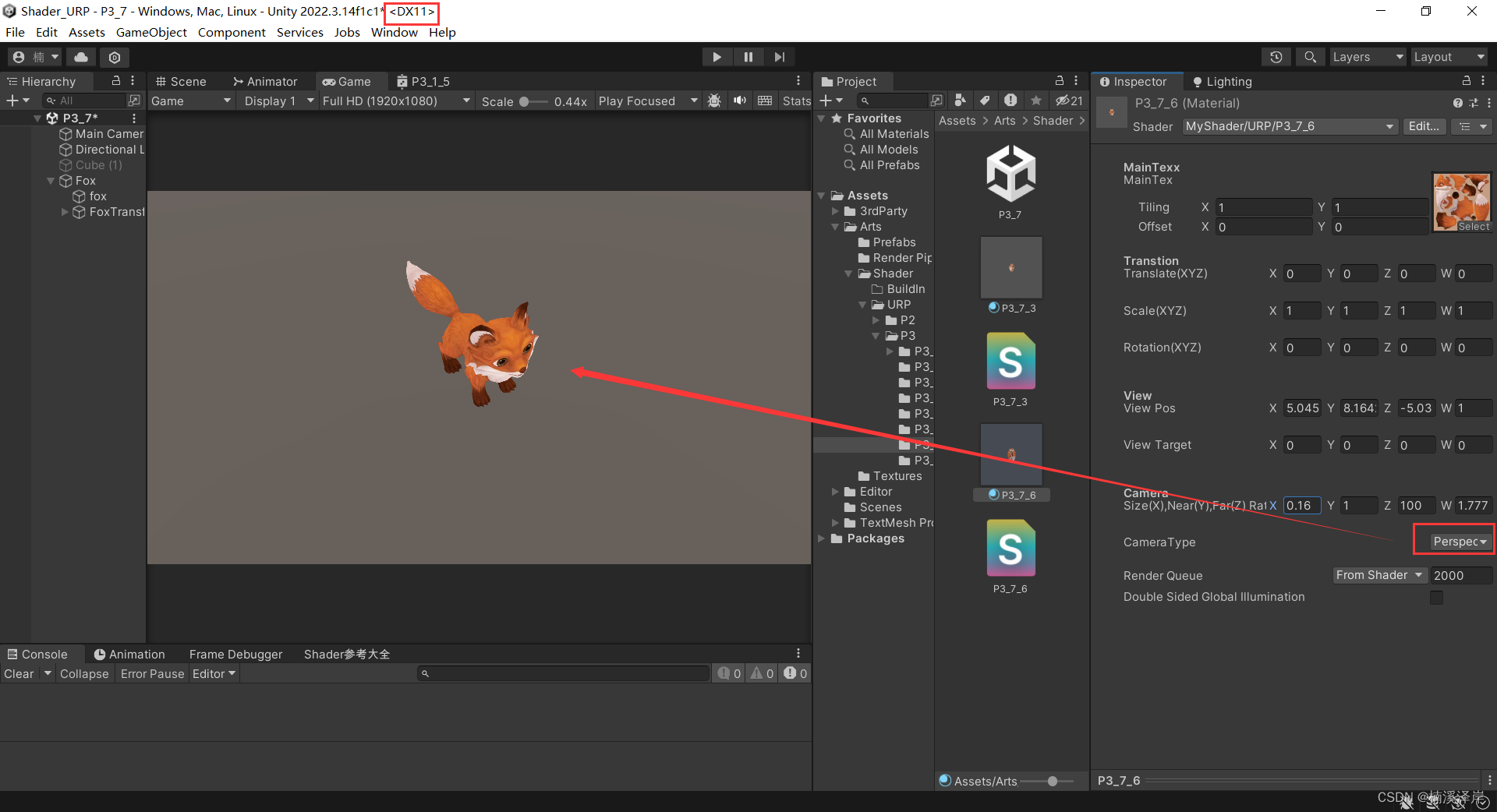Unity中Shader裁剪空间推导(在Shader中使用)
2023-12-29 20:34:56
文章目录
前言
在上一篇文章中,我们推导得出了 透视相机到裁剪空间的转化矩阵
我们在正交矩阵Shader的基础上,继续测试
在这篇文章中,我们在Shader中使用该矩阵测试一下。
- OpenGL
[ 2 v w 0 0 0 0 2 n h 0 0 0 0 n + f n ? f 2 n f n ? f 0 0 ? 1 0 ] \begin{bmatrix} \frac{2v}{w} & 0 & 0 & 0 \\ 0 & \frac{2n}{h} & 0 &0\\ 0 & 0 & \frac{n+f}{n-f} &\frac{2nf}{n-f}\\ 0 & 0 & -1 & 0\\ \end{bmatrix} ?w2v?000?0h2n?00?00n?fn+f??1?00n?f2nf?0? ? - DirectX
[ 2 v w 0 0 0 0 2 n h 0 0 0 0 n f ? n n f f ? n 0 0 ? 1 0 ] \begin{bmatrix} \frac{2v}{w} & 0 & 0 & 0 \\ 0 & \frac{2n}{h} & 0 &0\\ 0 & 0 & \frac{n}{f-n} &\frac{nf}{f-n}\\ 0 & 0 & -1 & 0\\ \end{bmatrix} ?w2v?000?0h2n?00?00f?nn??1?00f?nnf?0? ?
一、在Shader中使用转化矩阵
1、在顶点着色器中定义转化矩阵
- OpenGL:
M_clipP = float4x4
(
2n/w,0,0,0,
0,2n/h,0,0,
0,0,(n+f)/(n-f),(2nf)/(n-f),
0,0,-1,0
);
- DirectX:
M_clipP = float4x4
(
2n/w,0,0,0,
0,2n/h,0,0,
0,0,n/(f-n),(n*f)/(f-n),
0,0,-1,0
);
2、用 UNITY_NEAR_CLIP_VALUE 区分平台矩阵
- 1为OpenGL
- -1为DirectX
3、定义一个枚举用于区分当前是处于什么相机
[Enum(OrthoGraphic,0,Perspective,1)]_CameraType(“CameraType”,Float) = 0
- 在手动转化矩阵时使用三目运算符来决定使用哪一个矩阵
float4x4 M_clip = _CameraType ? M_clipP : M_clipO;
o.vertexCS = mul(M_clip,float4(vertexVS,1));
二、我们在DirectX平台下,看看效果
1、正交相机下

2、透视相机下

3、最终代码
//平移变换
//缩放变换
//旋转变换(四维)
//视图空间矩阵
//正交相机视图空间 -> 裁剪空间
Shader "MyShader/URP/P3_7_6"
{
Properties
{
[Header(MainTexx)]
_MainTex("MainTex",2D) = "white"{}
[Header(Transtion)]
_Translate("Translate(XYZ)",Vector) = (0,0,0,0)
_Scale("Scale(XYZ)",Vector)= (1,1,1,1)
_Rotation("Rotation(XYZ)",Vector) = (0,0,0,0)
[Header(View)]
_ViewPos("View Pos",vector) = (0,0,0,0)
_ViewTarget("View Target",vector) = (0,0,0,0)
[Header(Camera)]
_CameraParams("Size(X),Near(Y),Far(Z) Ratio(W)",Vector) = (0,0,0,1.777)
[Enum(OrthoGraphic,0,Perspective,1)]_CameraType("CameraType",Float) = 0
}
SubShader
{
Tags
{
"PenderPipeline"="UniversalPipeline"
"RenderType"="Opaque"
"Queue"="Geometry"
}
Pass
{
HLSLPROGRAM
#pragma vertex vert
#pragma fragment frag
#include "Packages/com.unity.render-pipelines.core/ShaderLibrary/Color.hlsl"
#include "Packages/com.unity.render-pipelines.universal/ShaderLibrary/Core.hlsl"
#include "Packages/com.unity.render-pipelines.universal/ShaderLibrary/Lighting.hlsl"
struct Attribute
{
float4 vertexOS : POSITION;
float2 uv : TEXCOORD0;
};
struct Varying
{
float4 vertexCS : SV_POSITION;
float2 uv : TEXCOORD0;
};
CBUFFER_START(UnityPerMaterial)
float4 _Translate;
float4 _Scale;
float4 _Rotation;
float4 _ViewPos;
float4 _ViewTarget;
float4 _CameraParams;
float _CameraType;
CBUFFER_END
TEXTURE2D(_MainTex);
SAMPLER(sampler_MainTex);
Varying vert (Attribute v)
{
Varying o;
o.uv = v.uv;
//平移变换
float4x4 M_Translate = float4x4
(
1,0,0,_Translate.x,
0,1,0,_Translate.y,
0,0,1,_Translate.z,
0,0,0,1
);
v.vertexOS = mul(M_Translate,v.vertexOS);
//缩放交换
float4x4 M_Scale = float4x4
(
_Scale.x,0,0,0,
0,_Scale.y,0,0,
0,0,_Scale.z,0,
0,0,0,1
);
v.vertexOS = mul(M_Scale,v.vertexOS);
//旋转变换
float4x4 M_rotateX = float4x4
(
1,0,0,0,
0,cos(_Rotation.x),sin(_Rotation.x),0,
0,-sin(_Rotation.x),cos(_Rotation.x),0,
0,0,0,1
);
float4x4 M_rotateY = float4x4
(
cos(_Rotation.y),0,sin(_Rotation.y),0,
0,1,0,0,
-sin(_Rotation.y),0,cos(_Rotation.y),0,
0,0,0,1
);
float4x4 M_rotateZ = float4x4
(
cos(_Rotation.z),sin(_Rotation.z),0,0,
-sin(_Rotation.z),cos(_Rotation.z),0,0,
0,0,1,0,
0,0,0,1
);
v.vertexOS = mul(M_rotateX,v.vertexOS);
v.vertexOS = mul(M_rotateY,v.vertexOS);
v.vertexOS = mul(M_rotateZ,v.vertexOS);
//观察空间矩阵推导
//P_view = [W_view] * P_world
//P_view = [V_world]^-1 * P_world
//P_view = [V_world]^T * P_world
float3 ViewZ = normalize(_ViewPos.xyz - _ViewTarget.xyz);
float3 ViewY = float3(0,1,0);
float3 ViewX = cross(ViewZ,ViewY);
ViewY = cross(ViewX,ViewZ);
float4x4 M_viewTemp = float4x4
(
ViewX.x,ViewX.y,ViewX.z,0,
ViewY.x,ViewY.y,ViewY.z,0,
ViewZ.x,ViewZ.y,ViewZ.z,0,
0,0,0,1
);
float4x4 M_viewTranslate = float4x4
(
1,0,0,-_ViewPos.x,
0,1,0,-_ViewPos.y,
0,0,1,-_ViewPos.z,
0,0,0,1
);
float4x4 M_view = mul(M_viewTemp,M_viewTranslate);
float3 vertexWS = TransformObjectToWorld(v.vertexOS.xyz);
//世界空间转化到观察空间
float3 vertexVS = mul(M_view,float4(vertexWS,1)).xyz;
//相机参数
float h = _CameraParams.x * 2;
float w = h * _CameraParams.w;
float n = _CameraParams.y;
float f = _CameraParams.z;
//正交相机投影矩阵
//P_Clip = [M_Clip] * P_view
float4x4 M_clipO;
if(UNITY_NEAR_CLIP_VALUE==-1)
{
//OpenGL
M_clipO = float4x4
(
2/w,0,0,0,
0,2/h,0,0,
0,0,2/(n - f),(n + f) / (n - f),
0,0,0,1
);
}
if(UNITY_NEAR_CLIP_VALUE==1)
{
//DirectX
M_clipO = float4x4
(
2/w,0,0,0,
0,2/h,0,0,
0,0,1/(f-n),f/(f-n),
0,0,0,1
);
}
//透视相机投影矩阵
float4x4 M_clipP;
if(UNITY_NEAR_CLIP_VALUE==-1)
{
//OpenGL
M_clipP = float4x4
(
2*n/w,0,0,0,
0,2*n/h,0,0,
0,0,(n+f)/(n-f),(2*n*f)/(n-f),
0,0,-1,0
);
}
if(UNITY_NEAR_CLIP_VALUE==1)
{
//DirectX
M_clipP = float4x4
(
2*n/w,0,0,0,
0,2*n/h,0,0,
0,0,n/(f-n),(n*f)/(f-n),
0,0,-1,0
);
}
//手动将观察空间下的坐标转换到裁剪空间下
float4x4 M_clip = _CameraType ? M_clipP : M_clipO;
o.vertexCS = mul(M_clip,float4(vertexVS,1));
//观察空间 转化到 齐次裁剪空间
//o.vertexCS = TransformWViewToHClip(vertexVS);
//o.vertexCS = TransformObjectToHClip(v.vertexOS.xyz);
return o;
}
half4 frag (Varying i) : SV_Target
{
float4 mainTex = SAMPLE_TEXTURE2D(_MainTex,sampler_MainTex,i.uv);
return mainTex;
}
ENDHLSL
}
}
}
文章来源:https://blog.csdn.net/qq_51603875/article/details/135295341
本文来自互联网用户投稿,该文观点仅代表作者本人,不代表本站立场。本站仅提供信息存储空间服务,不拥有所有权,不承担相关法律责任。 如若内容造成侵权/违法违规/事实不符,请联系我的编程经验分享网邮箱:veading@qq.com进行投诉反馈,一经查实,立即删除!
本文来自互联网用户投稿,该文观点仅代表作者本人,不代表本站立场。本站仅提供信息存储空间服务,不拥有所有权,不承担相关法律责任。 如若内容造成侵权/违法违规/事实不符,请联系我的编程经验分享网邮箱:veading@qq.com进行投诉反馈,一经查实,立即删除!